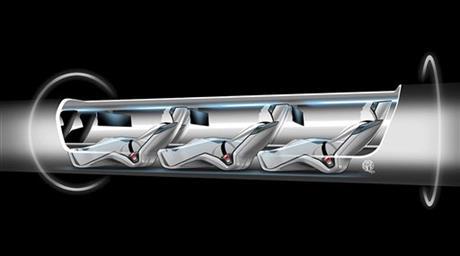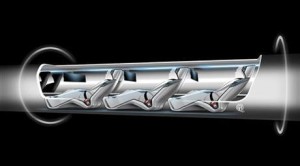Hyperloop – A Reality for Commuters?


As many of you may have heard, Elon Musk – founder of Tesla Motors, PayPal and SpaceX – released his plans for an extraordinary new mode of transportation, the Hyperloop.
Whether they are ‘his’ plans, and if it is a ‘new’ idea, is up for debate. But we’ll leave it there and focus on the idea itself.
So what is the Hyerloop? Remember those pneumatic tubes that transport capsules stuffed with paperwork in older buildings or drive-thru banks? That’s essentially what it is, a capsule moving through a tube. You would enter this capsule (the claustrophobic might want to find an alternative means of commuting), settle in, and then a force of acceleration would blast you through the tube. The capsules would be pulled down the line by magnetic attraction. Each capsule floats on a cushion of air, like a puck on an air hockey table. To reduce friction, a fan located at the front of the capsule would suck air to the rear in the already nearly air-free tube, creating a turbulence free ride to your destination. The system brings to mind that of Walt Disney’s Tomorrowland.
And will it work? Is it feasible?
Marc Thompson, a professor of electrical engineering at Worcester Polytechnic Institute in Massachusetts told ABC News that the core principles behind the Musk design should work, but travelling in pressurized tubes while encased in a pod went beyond core principles.
Ernst Frankel, an emeritus mechanical engineering professor at MIT (who also designed a tube-based high-speed public transit system in the mid ‘90s linking Boston to New York, and some might say where Elon Musk took inspiration for his idea) said the over 700 MPH speed Musk proposes runs risks. While trains have broken the sound barrier, we still don’t run passenger trains above that speed.
But can it actually be built?
Sure, it could be built, but I’m not sure if any of the barriers or obstacles Musk’s system might encounter were considered in this pie-in-the-sky presentation. First, there are the mountains in the Central Valley of California to get over, or under. Second, there are the land use and zoning laws and property rights to consider when building an elaborate system stretching approximately 381 miles from San Francisco to Los Angeles. Where’s it going to go? Third, Musk mentioned that his Hyperloop system would never crash and would be immune to weather. Never say never. Where a system is operated by humans, there will be likely be human error. And the weather? Perhaps not so much a concern, but what about the seismic activity prevalent in the San Andreas Fault? Furthermore, if the system is underground, how exactly will it be solar-powered? Fourth is the cost. The price tag for the system is between $6 and $10 billion. Unrealistic.
Many big cities and suburbs are facing a transportation breakdown. We eventually get to where we need to go, but often not without congestion, increasing pollution and oftentimes a headache. It’s no wonder engineers, scientists and tinkerers are looking for the next big thing in transportation.
Hopefully, some feasible solutions are just around the corner.
Burnes K (2013-08-21 00:04:21). Hyperloop - A Reality for Commuters?. Australian Science. Retrieved: Dec 07, 2025, from https://ozscience.com/news/hyperloop-a-reality-for-commuters/
 Follow
Follow
1 thought on “Hyperloop – A Reality for Commuters?”
Comments are closed.